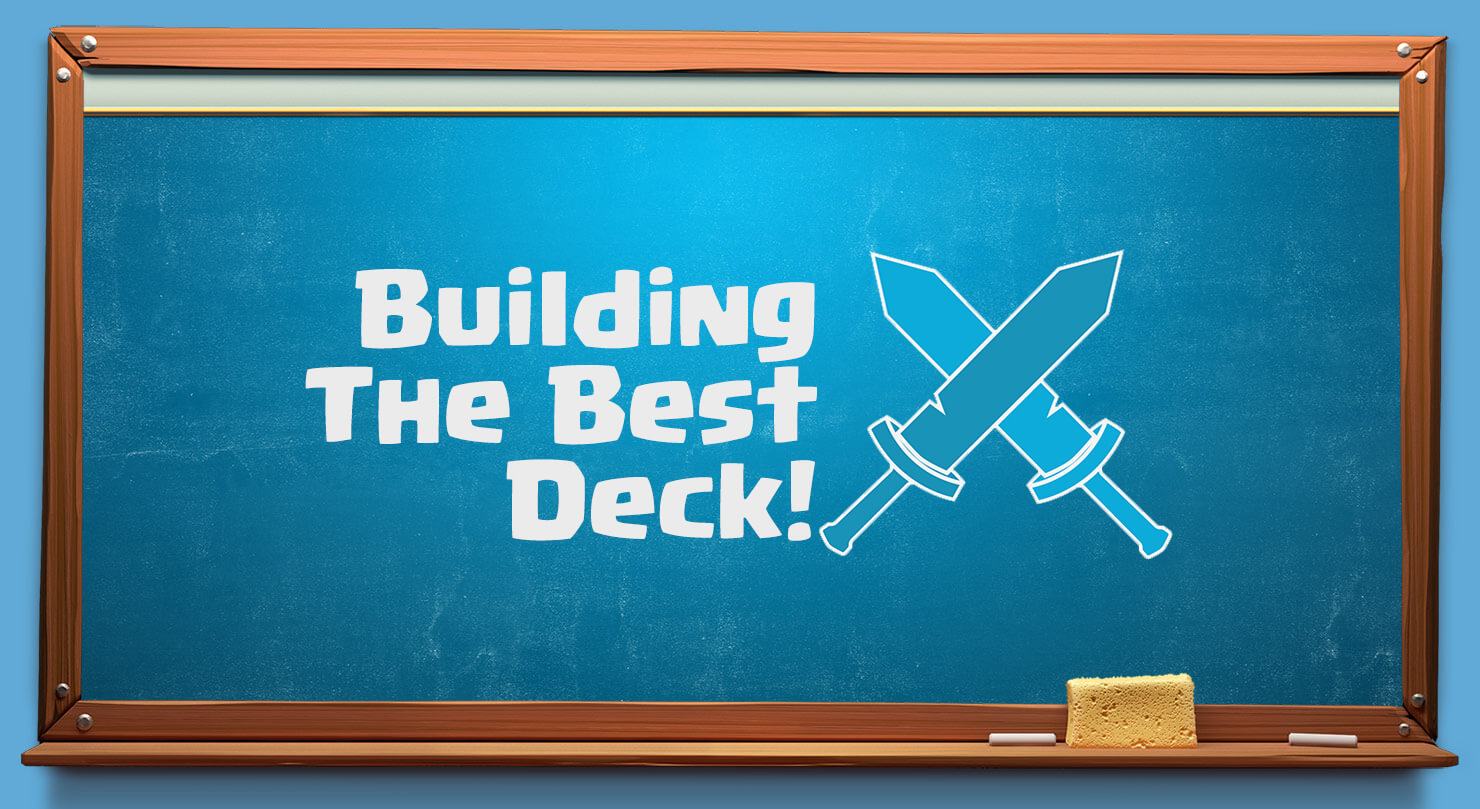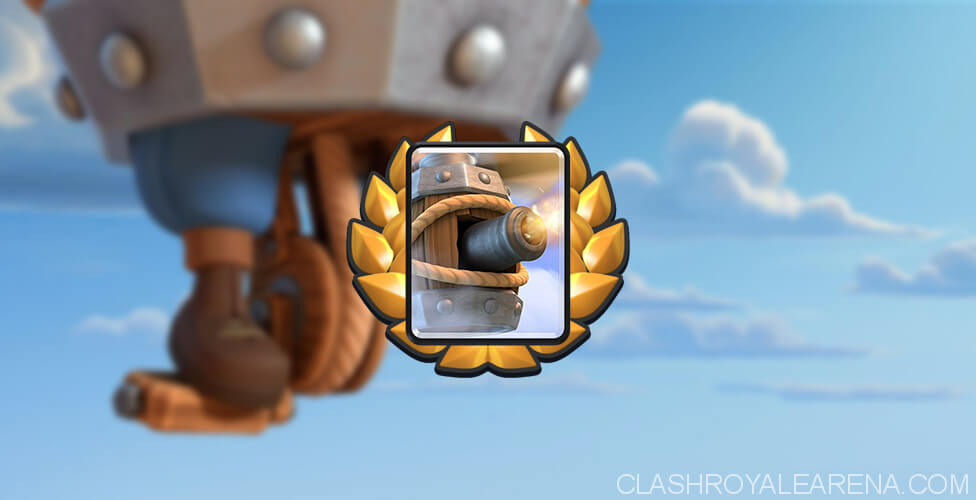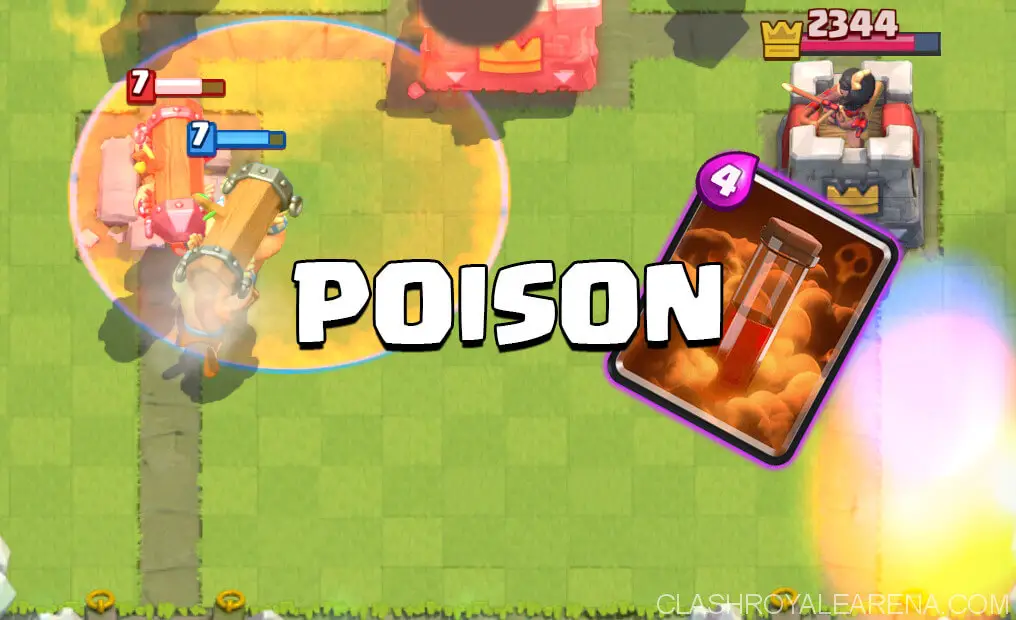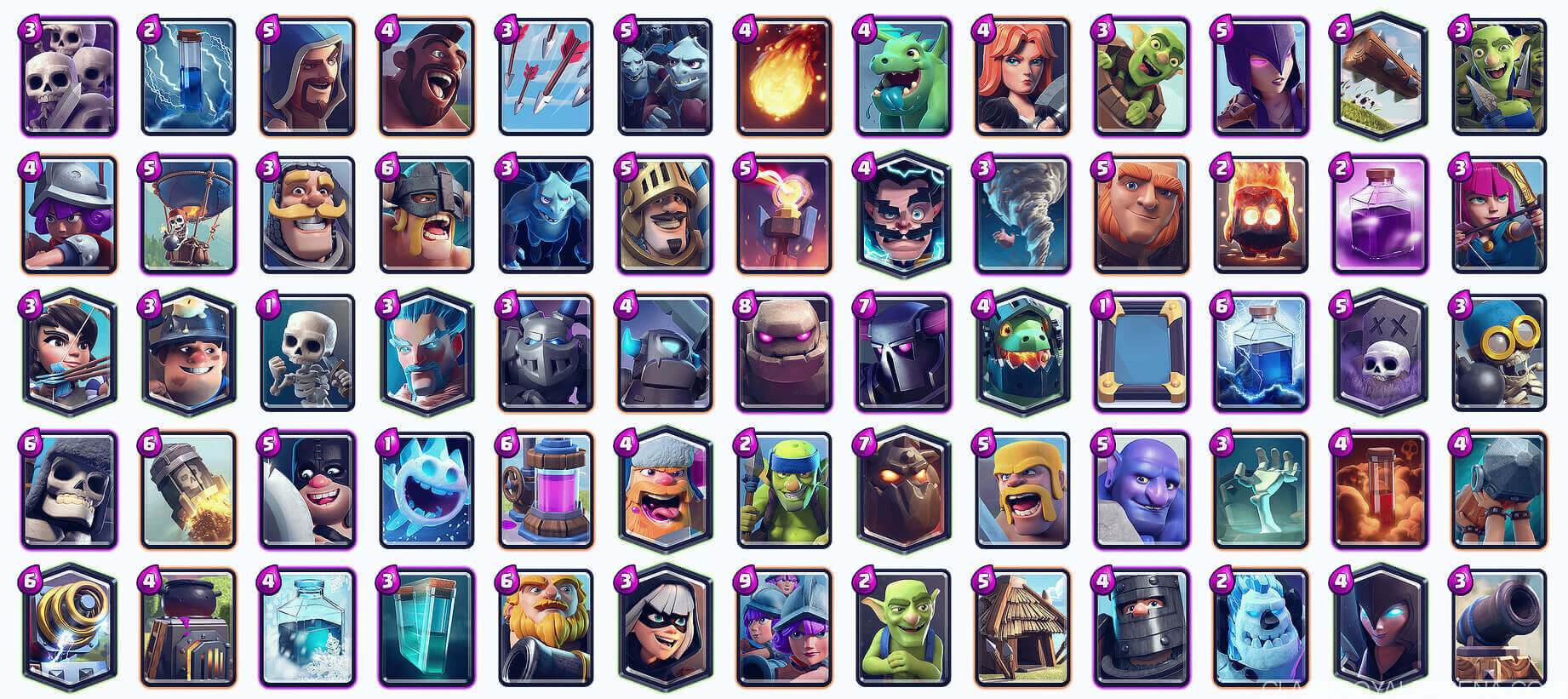Hello fellow Clashers! I’m KairosTime and today I’m bringing you Part IV to the “Strategy Guide to Clash Royale” with the Ultimate Guide to How to Build the Best Decks in Clash Royale.
This is a guide for new and experienced players alike and will complete your understanding of deck building.
To quote /user/IndoorBreathing88, a distinguished member of the Reddit community who has provided numerous strategy guides, “I would argue that skill is the most important factor in a match, and your deck gives you the tools to beat your opponent.” Having the right deck makes it possible for you to overcome your opponent, which is why good Deck Building is so essential!
There are 2 methods to build a solid deck.
The 1st is to use your previous experience and quickly throw something together and make changes after every few matches until you have something that works. This is what most people do most of the time, and it can be a very frustrating process, especially if you can’t find something that works very quickly. I do this when I want a quick deck to play around with.
When I’m serious about making an amazing deck, I follow the 2nd method to build a deck, which is to analyze the meta and make a deck that counters that meta. This Anti-Meta Deck Building Method takes time, especially the first 2-3 times you do it, but is the ultimate method in crafting the Best Decks!
In this guide, we will cover these key points
- Understanding the Different Metas
- Dissecting the Meta
- Building the Best Deck
- Testing and Refining your Deck
Note: This Strategy Guide is heavily inspired by guides written by /user/IndoorBreathing88.

Woogoo let’s begin!
Understanding the Different Metas
Before we can get into Dissecting the Meta and actual Deck Building, it’s important to first understand key differences between the different metas. I will be covering the different metas in order of what percentage of the active player base have access to them.
Non-Maxed Ladder
This is the meta that the vast majority of active players are in.
That being said, the meta in non-maxed ladder can fluctuate significantly depending on the Arena or League that you are in. I’ve even seen very different metas with a trophy difference of only 100 trophies.
Because it is easier to level up Commons and Rares than Epics and Legendaries, you can usually count on seeing Elite Barbarians, Royal Giants, Mortars, Giants, and Hog Riders as common Win Conditions in this meta. Other Commons and Rares are more likely to fluctuate so it’s important to use the correct tools to understand this meta.
Classic Challenges & Small Tournaments
This is probably the most diverse meta as long as the game is fairly balanced. Even when the game isn’t balanced very well, this will still be the most diverse meta because a lot of players in the meta have the resources to use the majority of the cards in the game.
This is where a lot of people will test out their decks and this creates an extremely fun and diverse meta.
Still, there is still some competitiveness in this meta, but not as much as in Grand Challenges.
Grand Challenges & Competitive Gameplay
Most people will only do a Grand Challenge if they think they have the deck and skill to do well.
This means that you will face players with the highest skill in Grand Challenges more than in Classic Challenges. This makes the Grand Challenge meta the most competitive meta that the majority of players have access to.
Because it is so competitive, this meta can change very quickly and a deck that wins a Grand Challenge one day may not even get 3 wins another day. This is because the meta will shift to counter yesterday’s meta
If you are serious about playing competitively, and you have the gems, this is a good place to test different decks before joining a competitive tournament.
Maxed Ladder
This is the meta that the fewest number of players have access to but it has a high level of influence on all of the other metas because everyone in the world can see which decks are being used here.
It’s important to realize that the top of the ladder has a different meta than anywhere else in the ladder because of card caps. It’s also a different meta than in Challenges because of the additional overtime and because of the max ladder decks are made to climb while tournament decks are made to win. Still, people copy max ladder decks all the time so it’s important to be aware of this meta.
Dissecting the Meta
If you’re serious about making a deck that really stands out, I would recommend pulling out a piece of paper and listing the most commonly used cards in the current meta under 4 different categories: Win Conditions, Support Troops, Defenses, and Spells. You can put 1 card in more than one category if it fits more than 1. For example, the PEKKA is a Win Condition, but can also be excellent on Defense.
If you include too few cards, it’ll be difficult for you to determine if your deck will actually do well. But if you include too many cards, you’ll get a headache trying to put a deck together that counters everything. I recommend including only the most common card and going from there.
Start filling up your paper with the most common cards that you can think of. You can also just make a mental note, but you’ll probably have more success if you take the time to write the cards down.
Here’s an example of what your initial list may look like based off of what’s on the top of your mind:
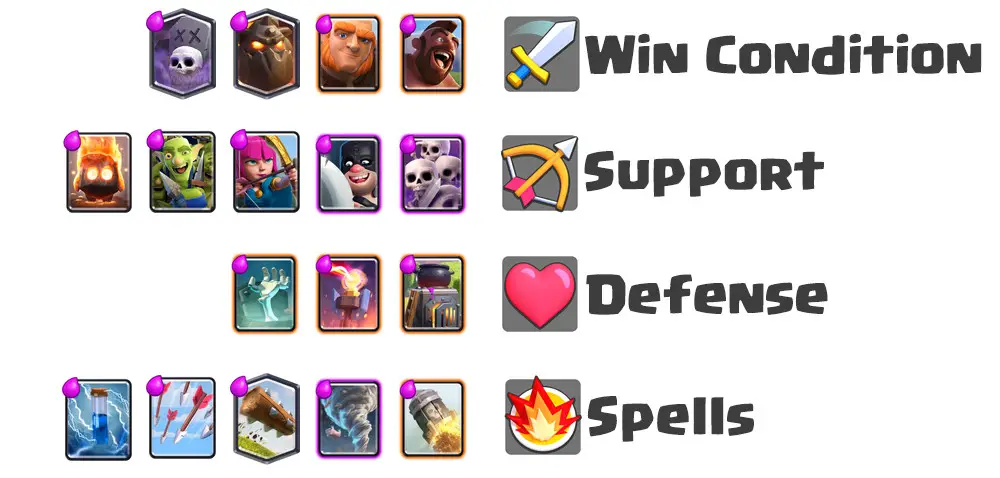
While looking at the most commonly used cards, you’ll want to also be aware of the Deck Archetypes and Deck Speeds that will be prominent in the Meta. I recommend selecting the ones that are the most common so you can build a deck with those common deck types in mind.
For more information on Deck Archetypes, Deck Speeds, and how to counter them, you can check my recent guide on Countering Every Deck – The Two Triangle Theory
| Fast Siege | Medium Siege | Slow Siege |
| Fast Beatdown | Medium Beatdown | Slow Beatdown |
| Fast Control | Medium Control | Slow Control |
If you’d like the best list, you can be thorough by taking a look at the following resources:
- Your Battle Log: Out of all of the resources you could use, this is the best place to start because you know that it is accurate for whichever meta you are playing in. This is especially helpful if the last 25 matches were in the meta that you are building your deck to counter.
- Top of the Ladder Battle Decks: As I said earlier, even though people would be better off making a deck for their own meta, it’s easy to copy top ladder decks and so a lot of people will do this. If you really want to be thorough, you could look through all of them, but I’m sure /user/IndoorBreathing88 will write you an excellent writeup on reddit at the end of each season detailing everything you need to know about the top of the ladder.
- Deckshop.pro: Pavelfi from Orange Juice is doing an excellent job keeping this up to date, and as long as he continues, this is an excellent resource to use when it comes to knowing which decks are doing really well in the Ladder, as well as decks that are doing really well in challenges.
- Statsroyale.com: This is an incredible resource that can be used to determine which cards are being used the most in any arena, as well as cards that are being used the most in challenges. It’s top Deck stats will even show win rates for each of the most popular decks.
Step 0 – Choose your Deck Type
If you made a mental list of popular cards and deck types, great! If you’ve taken the time to write down an actual list, even better!
The more effort you put into preparing yourself to counter these popular cards and deck types, the better your finished product will most likely be.
Now it’s time to choose a frame for your deck, or your Deck Type.
- If you are a Specialist (someone who only plays 1-2 types of decks), and you already know that you want to play a specific Deck Type, you can move on.
- If you are a Generalist (Someone who likes to play all types of decks) you’ll want to pull out the Two Triangle Cheat Sheet and look at the most popular Archetypes and Speeds
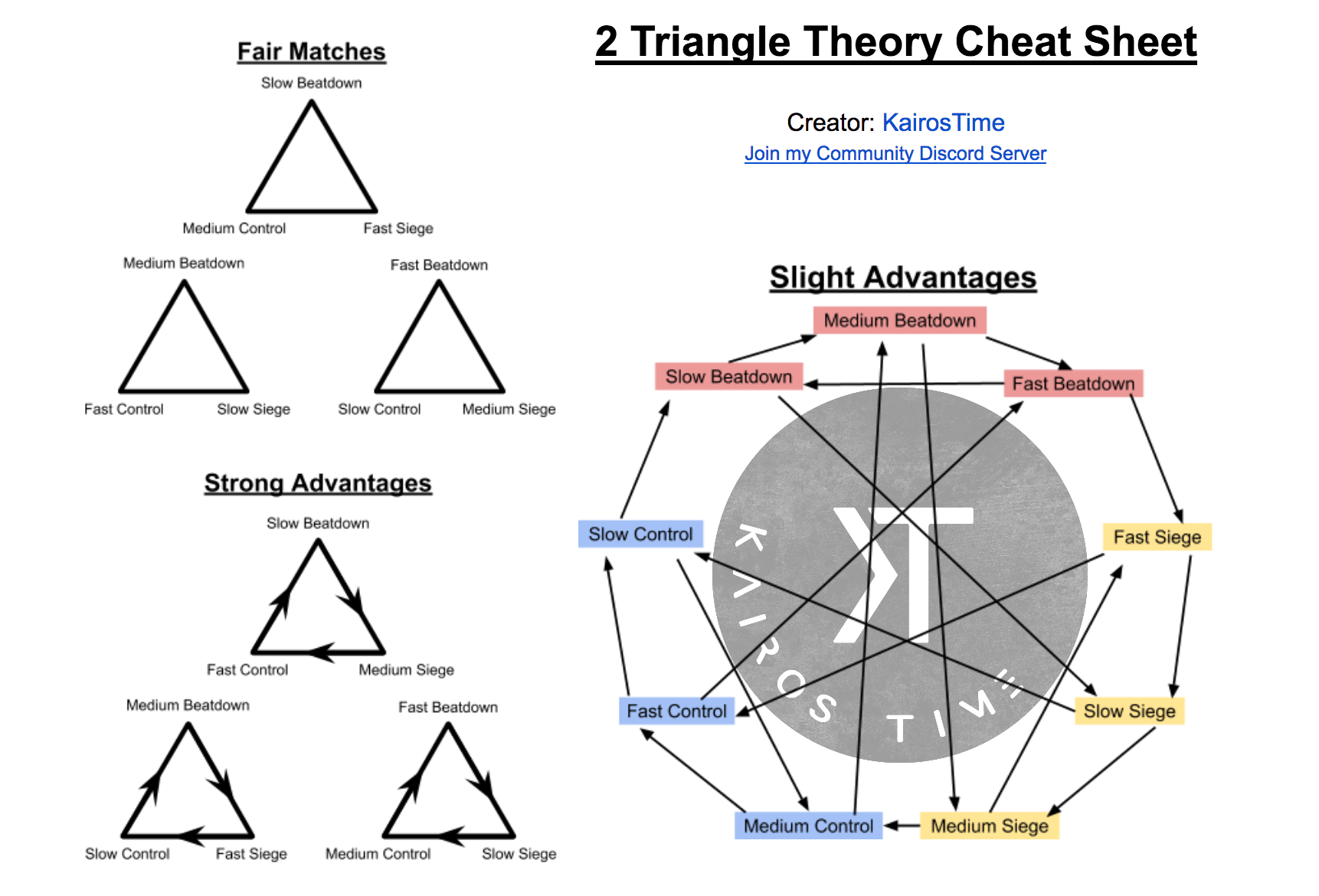
Are there 1 or 2 deck types that have a large or slight counter against the popular deck types? If there is, it may be a good idea to run with it, especially if it’s a deck type that you’re familiar with. If the choice isn’t obvious, do your best to find the best option based off of the meta, and your experience.
Now that you’ve selected your Deck Type, the next step is deciding which Utility Deck you want to build (Balance or Unity).
- A Balance Deck uses cards of different types in their deck to be able to defend against a lot of decks. Because they are balanced, they tend to have a fair matchup against most decks.
- A Unity Deck uses cards of a similar type to gain an advantage. Because they have multiple cards of the same type in their deck, they will be strong against some decks and weak against other decks. Two examples of Unity Decks are Lavaloon, and Spell Bait decks.
For more information on Balance and Unity decks, see my guide on Deck Building Fundamentals.
Now that you know which Archetype, Speed, and Utility you want to use as a framework for your deck, it’s time to finally start building your deck!
Deck Type > Deck Utility
Building the Best Deck
I am going to go through a step by step process of how to build the best decks.
Most of the time, I will follow this order, but it is completely acceptable to switch the order depending on your preference, or based off of an obvious meta.
Note: If you are building a ladder deck, it is important that you are aware of which cards are weak when underleveled, which cards are good even if they’re a little underleveled (level independent), and which cards are strong when overleveled. Keeping card rarity in mind is also a good idea as well. You may want to refer to these sites while choosing which cards to include in your deck but it’s important to recognize that card combinations and meta cards may play a bigger role in a good deck since every level is important in the game.
Step 1 – Win Condition
Even though you know which Archetype you plan on using, that does not make this an easy decision. The card you select for your Primary Win Condition will influence the rest of the choices you’ll make while completing your deck.
I recommend taking a good look at your list of commonly used cards, and doing your best to select a Win Condition that will not be easily countered by commonly used Defenses, Support Troops, or Spells.
For example, if cheap defensive buildings like the Cannon or Tombstone are popular, it might be better to use the Miner instead of the Hog Rider. However, if cheap defensive buildings are not popular, it might be better to go with the Hog Rider.
Here is a list of all of the current Win Conditions in the game:

After selecting your primary Win Condition based off of the most popular cards, you’re ready to further support your Win Condition to help take down enemy towers.
Note: By using https://www.deckshop.pro/card/list you select a card and scroll down to see which cards that card counters, and which cards counter it. If a card is in full color, it is a hard counter. If a card is faded, it is a soft counter. If you’re looking for counters to popular cards, this is an excellent resource. It’s also a great resource to help you think of counters that aren’t very popular, thus helping you create an anti-meta deck that isn’t also a meta deck.
Step 2 – Support your Win Condition
Even though you have selected a Win Condition based on countering the current cards, people will be familiar with countering almost all Win Conditions and so it’s likely that you’ll still have difficulty making your Win Condition successful.
You’ll now want to select 1 or 2 cards that will help overcome your opponent’s defenses so you can damage the enemy tower.
- Beatdown Decks – You will want to select 1-2 cards that will be able to deal significant damage to the enemy tower if they are successfully protected by your Win Condition. These cards should also do a good job at countering popular defenses to your Win Condition, since once your tank is gone, there may be little you can do to protect your support troops.
For example, the Electro Wizard does a great job at stunning Inferno Towers so they won’t clear your tank. - Control Decks – You will want to select 1-2 cards that will help your main Win Condition reach the tower and deal damage. This could be a spell, or a support troop that does a good job at countering the majority of the meta threats to your Win Condition.
For example, The Log could be used to help get a Hog Rider to the tower by clearing a defensive Goblin Gang. - Siege Decks – You will want to select 1-2 cards that will do a good job at protecting your Win Condition from common threats in the meta so that your Win Condition can lock onto the tower. This could be a spell, troop, or even another defensive building.
For example, Fire Spirits do a great job at clearing a lot of troops very quickly so your Siege card can lock onto the tower.

Step 2.5
If you want to build a Fast Deck and you selected some cards that are more expensive, you may want to consider cheaper cards.
Step 3 – Create an Anti-Meta Defense
Now that you have 2-3 cards in your deck that make up your Anti-Meta Offense, it’s time to select 2-3 cards that make up your Anti-Meta Defense.
You will want to start by making sure that you have counters to each of the popular Win Conditions on your list of meta cards.
While you don’t necessarily need a Hard Counter to every Win Condition, you will want a reliable way to deal with each popular Win Condition so that you can face a variety of decks. You will also want a reliable way to deal with popular Support Cards on your list of meta cards.
For your 2-3 cards for your Anti-Meta Defense, do your best to pick cards that will counter as many different popular cards as possible.
Note: As the meta adapts, these are usually the cards that I will switch up in my deck. If the meta changes to make my Win Condition unfavorable, I’ll usually start from scratch and build an entirely new deck.
Step 3.5
Now that you’ve selected 2-3 cards for your Anti-Meta Defense, go through your list of cards and make sure that your cards aren’t easily countered by the meta.
For example, the Inferno Tower does a great job at stopping a lot of Win Conditions, but if Electro Wizard, Zap, and Lightning are all popular, it would be better to use something else to defend.
Step 4 – Fill the Holes
At this point, you have anywhere between 4-6 cards in your deck and the deck will have some weaknesses that you will want to cover.
It’s now time that you ask yourself a bunch of questions to try and make sure that you select the best cards to fill those last slots. As you ask these questions, you can put different cards into these last 2-4 spots and move them around until you’ve found a deck that should be favorable for you each match.
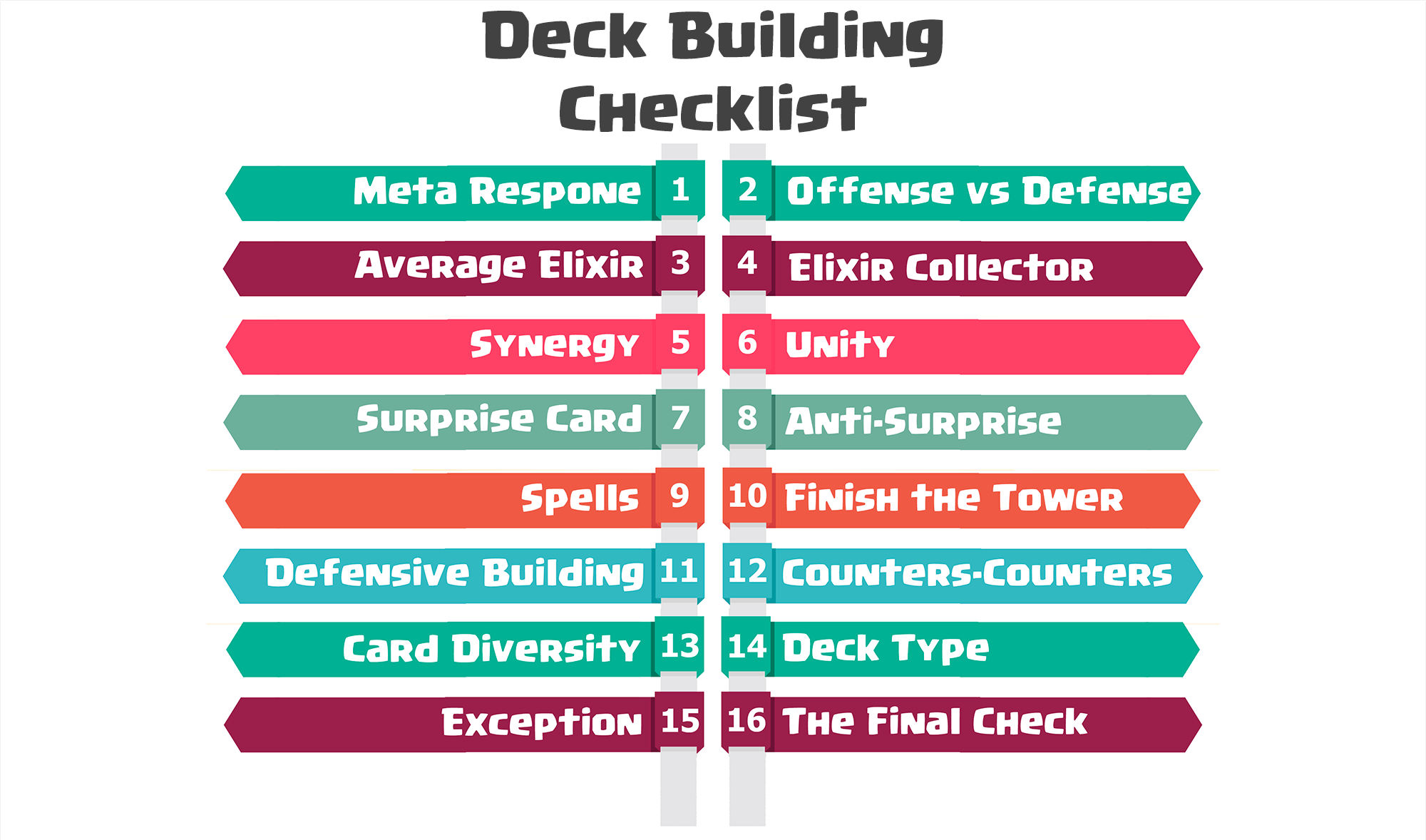
Meta Response – Do you have a response to all of the meta Win Conditions?
The best decks have a way to deal with all of the popular Win Conditions, so if your answer is no, you’ll want to make changes to your deck so that you do have a response before moving on. While it’s good to have hard counters to everything, this is fairly unreasonable. You at least want to make sure you have soft counters and a plan on how to deal with every meta Win Condition though.
Offense vs Defense – Do you have enough offense to take out an enemy tower? Do you have enough defense to defend a push?
The amount of offense and defense you’ll want in your deck is going to depend on the type of deck you build as some decks focus more on offensive gameplay and other decks focus on defensive gameplay. Regardless of the deck, if you don’t have enough offense or defense it’ll be difficult to win every match.
Average Elixir – In order to build the deck type you wanted to build, do you have to increase or decrease your average elixir.
While you may not care too much about your Average Elixir cost, the speed of your deck is going to influence how you should play your deck so it’s important to at least be aware of this.
Elixir Collector – Would your deck benefit from adding an Elixir Collector in it or would it be better to fill a slot with another card?
Some heavy decks do really well with an Elixir Collector while others would do better with some more support, or even with a cycle card.
Synergy – Would some of your cards work even better in your deck if they had another card to synergize with it?
There are some successful decks that have very little synergy between cards because their cards are all very good by themselves. However, most of the time you want some cards to work well together. (Examples: Executioner with Tornado. Elite Barbarians with Fire Spirits)
Unity – Would adding a card that is similar to a current card make it difficult for my opponent to deal with both cards?
By selecting multiple cards that have similar characteristics, it can make it difficult for your opponent if they only have 1 response to the two cards in your deck. (Examples: Skeleton Army and Goblin Gang. 3 Musketeers and Elixir Collector)
Surprise Card – Do you have a surprise card that is unpopular but that would be good to use?
I highly recommend using at least 1 card in your deck that people aren’t used to countering. This gives you the element of surprise, and also encourages your opponent to make poor moves against this surprise card. The surprise card you select should add something to your deck that you need in addition to the element of surprise. Don’t just pick a card because it’s unpopular. (Examples: Freeze, Giant Skeleton, Bomber)
Anti-Surprise – Do you have a way to deal with a situation where your opponent catches you off guard?
In the heat of battle, you never know if your opponent is going to do something that you simply couldn’t expect. It’s a good idea to have a way to deal with surprise cards like Freeze or Rage. Versatile response cards of low cost like Goblins or Ice Spirits are good at fitting into this role.
Spells – Do you have at least 1 direct damage spell?
Do you have too many spells in your deck? Do you have the best spell for your deck? You will want at least 1 spell in your deck, and you will want to make sure that you don’t have too many in your deck. While the sweet spot is usually 1 or 2 spells, some decks with 3 Spells can do well too. I also recommend asking if you chose the right spell for your deck. (Examples: Zap, or log. Arrows or Tornado. Rocket or Lightning)
Finish the Tower – Do you have some way to finish off a tower without building up a push?
While you can put all of your efforts into building up a massive push that can’t be stopped, there will always be situations where the difference between winning and losing is whether you have a way to easily damage the enemy tower. It’s a good idea to at least have 1 way that you can quickly deal 200-400 damage to an enemy tower. This could be a spell, or even an unpredictable strategy to take your opponent off guard. (Examples: Miner, Fireball, etc.)
Defensive Building – Would your deck benefit from a defensive building?
Buildings are typically really good on defense but can make it difficult to build up an offensive push. They also slow down the tempo of the match which may be a good thing or a bad thing depending on the way you want to play your deck.
Counters to Counters – Do you have counters to the cards that counter your cards?
If you’re using a heavy tank, you should plan on having an answer to Inferno Towers. If you’re using the Graveyard, you should have some way to get rid of swarm troops. If you don’t have counters to your counters, your offensive options will get stopped more times than not.
Splash, Glass Cannons, Swarms, Tanks, Ground, & Air – Do you have ways to deal with decks that have a lot of Splash troops, Glass Cannons, Tanks, Ground threats, or decks that have a lot of Air troops?
These are the most common Unity Decks found in the game and you want to make sure you at least have a way to deal with each Unity Deck. This could mean having a specific strategy in mind, or having cards that counter each of them.
Deck Type – Did you create the deck type that you originally decided to make?
If you did, that’s awesome! If you didn’t, you can either stick with what you made, or make some changes in order to make what you want to make. What’s important is that you know what you made so you can play it the right way.
Counter Card Exception – Do you have a way to deal with deck types that have an Advantage over you according to the Two Triangle Theory?
Even though your deck may have cards that do a good job at responding to a lot of popular cards, it’s important to be aware of the types of decks that your deck will have a disadvantage to because of its Archetype and Speed.
The Final Check – Check your deck on deckshop.pro’s Deck Checker.
Do you have a Mediocre or Bad rating in any category? Are there any problems with your deck that need to be fixed? Are there any cards that could give you trouble?
This is an incredible resource at helping you think of anything else that you might have missed. Because the site can’t count for every troop interaction or troop combination, it may suggest an issue with your deck that isn’t accurate. The best thing to do is use your intuition to make all final calls.
When I ask myself these questions, I will switch multiple cards in and out of my deck until I feel confident that I have a solid deck. After I’ve gone through these questions once, I’ll go through the process again until I don’t make any more changes. This takes some time but it’s helpful in 2 ways. 1st, it’ll help you create a solid deck to counter the meta as well as other anti-meta decks. 2nd, it’ll give you an idea of how you want to play your deck before you find yourself in difficult situations.
Testing and Refining your Deck
Now that you’ve invested some good time into making this deck, it’s time to finally go and test the deck so that you can refine the deck into its final product! Here are some tips and suggestions to do so.
Play in the Right Meta
If you made a deck to counter the Ladder meta, test the deck in the Ladder. If you’re like most players, you’ll likely drop some trophies as you get used to your new deck, but that’s ok.
The meta where you’re at in the Ladder is probably very different than the meta in Classic Challenges so you’ll be doing yourself a disservice by making changes to your deck according to cards in the Classic Challenge Meta.
If you want some practice before jumping into the ladder, I recommend asking your clan mates to play against you with their ladder deck.
If you want to make a Tournament deck to rock it in the Competitive scene of Clash Royale, I recommend testing your deck in Classic Challenges first, and then testing your deck in Grand Challenges. If your deck does well in both metas, you’ve got a good deck that does well in the competitive meta (Grand Challenges), but can also handle unique situations that are found in a fluid meta (Classic Challenges).
Make Calculated Changes
As you begin to get a feel for your new deck, you’ll be tempted to make a change after every loss. Just because you lose once or twice doesn’t mean the deck is bad. You may still need more practice with the deck, and the matchups may have been more unfavorable for you.
In my experience, if you want to make a change to your deck, it’s a good idea to play 5-10 matches in the right meta before doing so.
As you decide to make changes, you’ll have the most success as you watch your replays for those moments where you felt like you couldn’t do anything. Pause the replay and look for something you could have done with your current cards. Ask yourself if you could have fixed the problem by playing differently, or if switching out one of your cards for another would have been helpful. You may have also lost because of a bad card rotation, so look for that as well.
Then try to make changes that will add to your deck without taking too much away.

Conclusion
Now that you have a firm understanding of how to analyze the meta and make a deck that will succeed in it, you now have the tools to create the best decks in Clash Royale. As you go through this process more and more, it’ll take less time and effort while still providing great results.
Thanks so much for reading this guide! If you’re interested in learning more, make sure to subscribe to my YouTube Channel so you can be the first to see my guides. If you have any questions, feel free to leave them as comments on my video and I’ll get back to you as soon as I can!
Want to be a part of a community who love Clash Royale as much as you do? We probably have what you’re looking for in the Kairos Kingdom Community Reddit! Join Today!
Ticking By,
KairosTime


